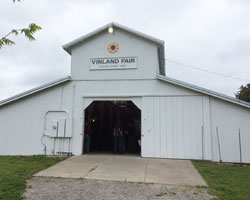First Forest Legacy Program project established in Kansas
The project is on the site of Baldwin Woods Forest Preserve in Douglas County. Photos and captions available
Photos and captions available
Released: May 23, 2016
LAWRENCE, Kan. – On Saturday, April 30, many gathered at the historic Vinland Fair Barn just south of Lawrence to celebrate the dedication of the first Forest Legacy Program project in Kansas. The program has just been established as part of the Baldwin Woods Forest Preserve.
Thanks to the cooperation of a group of organizations, the Baldwin Woods Forest Preserve, part of the University of Kansas Field Station, has more than doubled from 202 acres to 456 acres, and is now unified as one contiguous tract. A segment of that property will be the first Forest Legacy Program project in Kansas.
With a Forest Legacy grant from the U.S. Forest Service, the Kansas Forest Service at Kansas State University selected Baldwin Woods as a conservation site. Additional funding was provided by The Conservation Fund, the U.S. Fish and Wildlife Service, and a Douglas County Heritage Conservation grant.
“Protection of Kansas woodlands from development has been largely missing from our conservation efforts in Kansas for many reasons,” said Bob Atchison, rural forestry program coordinator for the Kansas Forest Service at Kansas State University. “Partnerships were critical for this success.”
Conservation partners for the project include the U.S. Forest Service’s Forest Legacy Program, the Kansas Forest Service, the Conservation Fund, the Douglas County Heritage Conservation Council, KU Endowment, and the Kansas Biological Survey.
Landowners Ray Wilber, Cathy Dwigans, and John and Gloria Hood, of Baldwin City, Kansas, sold the lands for the expansion below market value specifically to integrate them in the forest preserve.
The greater Baldwin Woods, named a National Natural Landmark in 1980 by the U.S. Secretary of the Interior, is recognized as a site of environmental significance. It lies within an ecotone, the border region where the North American eastern deciduous forest meets the tallgrass prairie. Therefore, many species live at the western extremes of their geographic ranges, and subtle shifts in climate may affect their populations to a greater extent than farther east, Atchison said. This makes the Baldwin Woods Forest Preserve, which is one of the highest-quality protected timber stands of the eastern forest in Kansas, extremely valuable to the study of ecosystem dynamics and climate change.
Thanks to the commitment, dedication and patience of the state forester, Larry Biles and other partners, the woodlands, and hopefully many others, will be protected and studied for generations to come, Atchison said.
-30-
K‑State Research and Extension is a short name for the Kansas State University Agricultural Experiment Station and Cooperative Extension Service, a program designed to generate and distribute useful knowledge for the well‑being of Kansans. Supported by county, state, federal and private funds, the program has county Extension offices, experiment fields, area Extension offices and regional research centers statewide. Its headquarters is on the K‑State campus in Manhattan.
For more information, contact:
Jennifer Williams, communications coordinator, Kansas Forest Service
785-532-3308 or jgwilliams@ksu.edu
